#ammonoid fossil
Explore tagged Tumblr posts
Photo

Fossil Goniatite Devonian Elfoud Morocco Genuine Specimen
This listing features a genuine and visually striking Fossil Goniatite from the Devonian Period (approximately 419 to 359 million years ago), discovered near Elfoud, Morocco, a region famed for its fossil-rich sedimentary formations.
Geology & Origin:
The rocks surrounding Elfoud were deposited in a warm, shallow marine environment during the Devonian—often referred to as the “Age of Fishes.” Goniatites, ancestors of modern cephalopods, were common in these seas and are typically found preserved within fine-grained limestone and shale. Their coiled shells were rapidly buried by sediment, enabling excellent fossil preservation that still showcases intricate chambered spirals today.
Fossil Type & Classification:
Type: Fossil Goniatite (Extinct marine cephalopod)
Geological Period: Devonian
Locality: Elfoud, Morocco
Preservation: Excellent, with well-defined chambered shell pattern and polished surface
Features:
100% genuine, natural fossil specimen
Supplied with a Certificate of Authenticity
Hand-selected for detail, polish, and visual quality
The exact specimen shown in the listing photographs
Scale cube = 1cm: See photo for full dimensions
Why Buy From Us? We specialise in offering authentic, expertly prepared fossils that are scientifically significant and aesthetically appealing. Every item includes a Certificate of Authenticity, ensuring full transparency and value.
Perfect for fossil collectors, educators, or as a decorative piece of Earth’s prehistoric marine history.
#Fossil Goniatite#Devonian Fossil#Elfoud Fossil#Moroccan Fossil#Ammonoid Fossil#Marine Fossil Morocco#Goniatite Shell Fossil#Authentic Devonian Fossil#Fossil with Certificate#Natural History Fossil#Fossil Collector Specimen#Ancient Cephalopod Fossil#Fossil Display Piece
0 notes
Text

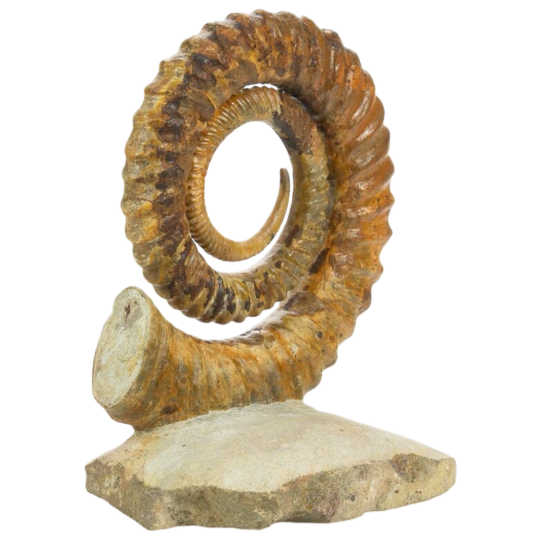
3.5" Early Devonian Ammonoid (Anetoceras) - Tazarine, Morocco
#devonian#anetoceras#ammonoid#ammonite#png#transparent#paleontology#paleo#prehistoric#fossil#fossils#fossil shell
425 notes
·
View notes
Text

Work in progress on a goniatite painting. What other critters should I add?
#geology#geologyjohnson#palaeontology#fossils#fossilfriday#fossil#paleontology#ammonite#ammonoid#Goniatite#cephalopods#cephalopod
190 notes
·
View notes
Text
SIDELINED SEASHELLS: REAPPRAISAL OF THE MIDDLE TRIASSIC AMMONOIDS OF SAMOBOR AND ŽUMBERAK MTS. (NORTH-WESTERN CROATIA) AND THEIR SYSTEMATICS AND BIOSTRATIGRAPHIC IMPLICATION
Published 7th September 2023
Ammonoid fossils from the Basinal Middle Triassic of the Samobor and Žumberak Mts in north-western Croatia are formally described and identified, revealing an impressive range of diversity within the region.

Topographic map of the Samobor and Žumberak Mts. area, The schematic stratigraphic columns of the localities of interest (1-late diagenetic dolostone, 2- shallower-water thick-bedded limestone, 3- thinly bedded, marly limestones, with occasional occurrences of chert and pyroclastic rocks, 4- grey to red nodular silicified limestone with lenses/layers of ammonitic limestone and pyroclastic rocks, 5- bedded hemipelagic limestone with cephalopods and juvenile pelagic bivalves, 6- radiolarian chert, 7- pyroclastic rocks, 8- occurrence of the bivalve Daonella, 9- occurrence of ammonoids)
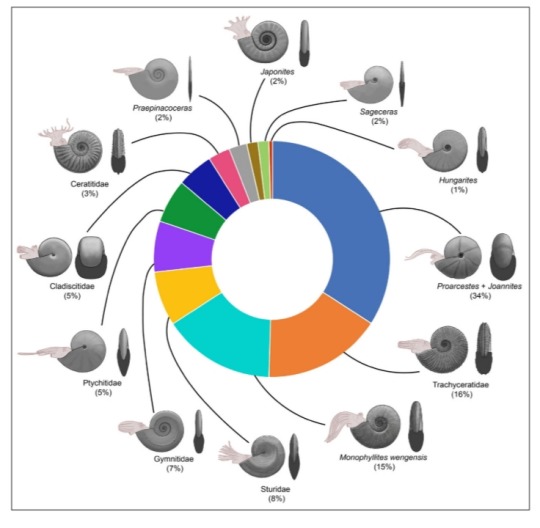
Proportion of the ammonoid taxa from the historic collections of the relevant institutions


A list of examined ammonoid taxa collected from the red nodular limestone facies of the Gregurić Breg locality, A list of known ammonoid taxa collected at multiple neighbouring localities in the Žumberak Mts
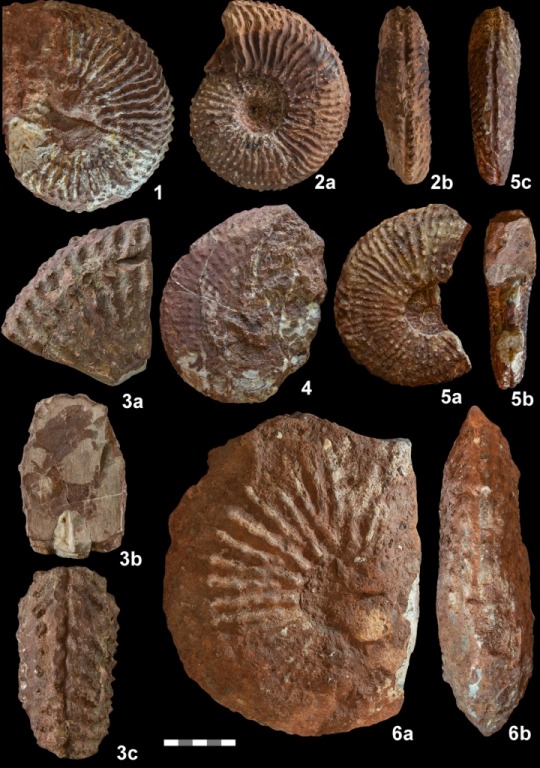
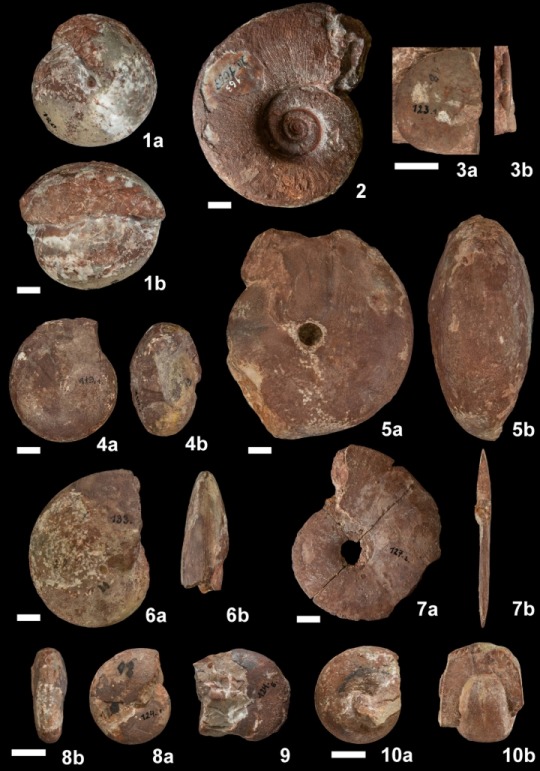

examples of the described ammonoid fossils
source:
9 notes
·
View notes
Text
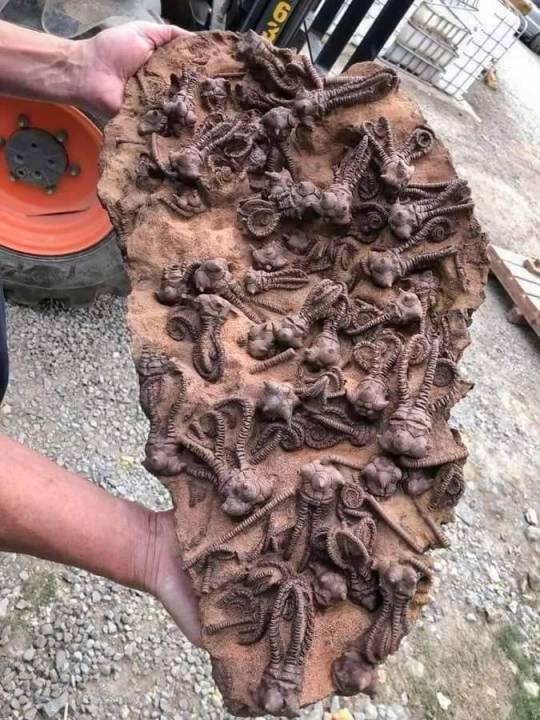
The fossils you’re seeing are from the Jimbacrinus crinoid, found in Western Australia (Gascoyne Junction), and they’re believed to be approximately 280 million years old.
These marine creatures, also known as sea lilies, lived during the Permian period. The fossils are usually found complete and have not been uncovered in any other location. They were first discovered in 1949 by the manager of Jimba Jimba cattle station, for which the genus was named.
The Permian period was the final period of the Paleozoic Era, lasting from 298.9 million to 252.2 million years ago. The climate was warming throughout Permian times, and, by the end of the period, hot and dry conditions were so extensive that they caused a crisis in Permian marine and terrestrial life.
The Permian seas were dominated by bony fishes with fan-shaped fins and thick, heavy scales. There were large reef communities that harbored squidlike nautiloids. Ammonoids, with their tightly coiled, spiral shells, are also widespread in the Permian fossil record.
Gascoyne Junction is a remote area in Western Australia known for its geological diversity. Geologists have determined that magmatic fluids came up from the earth’s mantle repeatedly over the past 1600 million years, depositing minerals along a fault line in the Gascoyne region. This area is also known for its remarkable fossil finds, including the Jimbacrinus crinoid fossils. This specimen is part of the collection at Crystal World, under the ownership of Tom Kapitany.
351 notes
·
View notes
Note
are you a girl who likes to reblog
i think we should've been able to have more cephalopods that have a true shell in the modern day
At the very least more nautiloids if not having ammonoids farting around in the ocean as well
While i am appreciative of the extant nautilus out there, especially the crusty nautilus

I do think i would benefit from at least one extant ammonite, according to fossil records they were more similar to squid than the nautilus AND could retract almost fully into their shell (as noted by fossilized remnants of the hardened rings of their suckers hooks within the shell cavity in some cases including one i have)
the hooks
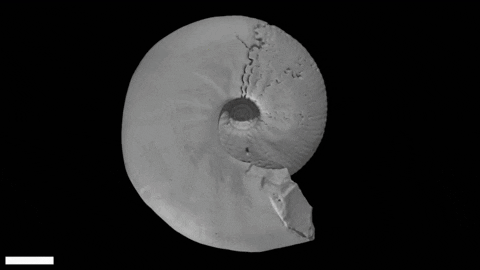
(a link to the article, idk if it's where i originally read it)
It's pretty cool that it's a soft tissue fossil, with how rare that is to fossilize in general, but with just how many ammonites are found it makes sense there would be at least one
#girl detector ramblings#self detection ask#nautilus#ammonite#love this animal; the naughty lass#naughty lass
15 notes
·
View notes
Text
Fossils

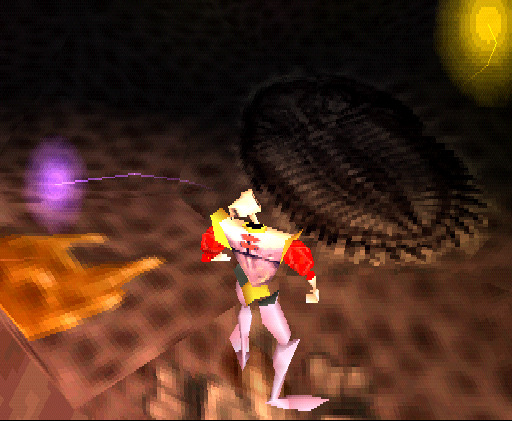
Did you notice? There are what appear to be trilobite and ammonoid fossils in The Ant Caves.
See more about ammonoids and trilobites on Gallowpedia.
#gallowpedia#medievil wiki#medievil#sony playstation#playstation#ps1#retro gaming#fossils#ammonite#trilobite
9 notes
·
View notes
Text
I WANT ALL THE PALEZOIC PALS FOR MY PLUSH JUNGLE!
can someone tell me whats the difference brown and green trilobites?
If you have ever been tempted by a Paleozoic Pal, like a a stuffed trilobite or a full size eurypterid body pillow, now's the time to buy one, before they and a really lovely little museum are gone for good 😭😭😭
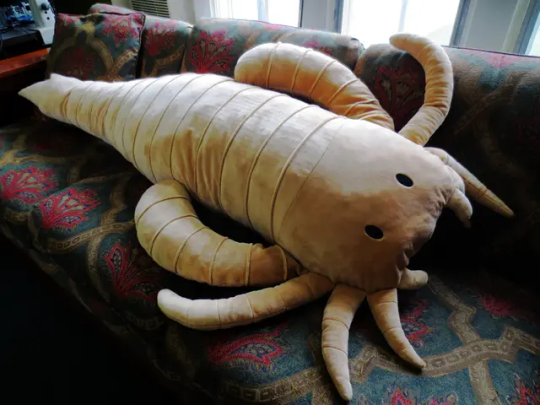
#museum of the earth#paleozoic#i had this museum on to visit list when i go to new york#save the fossils#paleozoic pal#go get it#Paleontological Research Institution#trilobite#eurypterid#ammonoid#paleontology
43K notes
·
View notes
Text
Shaligram Stone All You Need To Know about Shaligram
Shaligram Stone is found in the Kali Gandaki River in Nepal at Muktinath. Shaligram Shila is worshiped by many families and in temples around the world. In this blog, I will answer some central questions and topics about Shaligram.
What is Shaligram?
Shaligram story in Hinduism
How to worship Shaligram Stone?
Types of Shaligram Stone
Which Shaligram is best for worship at home?
How to identify the original Shaligram Shila?
Shaligram stone benefits worshiping at home
What is Shaligram Stone: Shaligram is a Blackstone brought from the banks of the Kali Gandaki River in Nepal at Muktinath. It is a holy stone worshipped by Vishnu Bhakts in temples and families worldwide. It is the most sacred and holy stone worshipped by the Vaishnavas (Especially those who worship Lord Krishna). There are different types of Shaligram with different names, and all of them are considered auspicious idols of Lord Vishnu. Vajrakita (a kind of ancient insect with strong teeth) has different types of chakra curves.
In scientific name, Shaligram is a black-colored Ammonoid fossil from millions of years ago. Shaligram story in Hinduism: According to the Devi Bhagavata Purana/Brahmavaivarta Purana & Shiva Purana in Hinduism. Shaligram Stone is Lord Vishnu, and Tulsi is worshiped story mentioned in Purana. There was a king named Vrishadhvaja, and he was a big devotee of Lord Shiva. He only worships Lord Shiva and refuses to worship another deity because he refuses to worship another deity. Lord Suriya Dev cursed him to suffer from poverty and the loss of his all kingdom. After many years, the grandson of Vrishadhvaya, Dharmadhvaja & Kusadhvaja came to know the reason behind their poverty. They performed very hard Tapasya(propitiate austerities) to Goddess Laxmi to regain their prosperity. Finally, Goddess Laxmi was pleased with their austerities (Tapasya). She blessed them with prosperity and even promised them she would take birth as a daughter in their life.
Both brothers were blessed with a daughter. Dharmadhvaja's daughter Tulsi( Vrinda), and Kusadhvaja's daughter, are Vedavati (Sita Devi). Tulsi and Vedavati are both avatars (incarnations) of Goddess Laxmi. Tulsi went to Badrinath to perform Tapasya. (austerities) to get Lord Vishnu as her husband in that life, she had to marry Shankhachuda( Jalandhara). Shankhachuda was Sudama ( a Lord Vishnu Saywak/devotee/reside) in the previous birth. For some reason, Sudama was cursed by Radha to take rebirth as a Danava, so as a result, Shankhachuda took birth from out of Vishu's body. He was mighty from his natural birth from Vishnu itself, and he was a big devotee of Lord Vishnu. Shankhachuda is very virtuous & religious to Lord Vishnu. He was the leader of Danavas (giant). Lord Bharma suggested he marry Tulsi to become more powerful, and he did that. (Lord Bharma knows that Goddess Laxmi is Tulsi and Shankhachuda a natural birth from Lord Vishnu itself).
Shankhachuda announced a battle against devatas. He won against many Gods in his leadership, and even he won Svarga (Heaven) and made out all gods from it. All Gods went to Lord Shiva to protect them and help them regain their respect and kingdom.
Finally, Shankhachuda announced a battle against Lord Shiva to rule Kailash Parvat (Mount Kailash). Lord Shiva also announced a battle against him to give back God's respect and kingdom. There was a battle between Devatas and Danavas (God and Giant) for a long time, but the result was not coming. Lord Bharma suggests to Lord Vishnu that due to Shankhachuda's virtue and his wife, Tulsi Pativrata (purity), protect him. So no one can beat him in battle. So it would help if you violated Tulsi Pativrata to win against Danavas. Once, when Shankhachuda was busy in battle fighting with Lord Shiva, Lord Vishnu took the form (counterpart) of Shankhachuda and went to Tulsi and cohabited (Physical intimacy) with her. Tulsi lost her Pativrata (purity). Meanwhile, Shankhachuda was killed by Lord Shiva because Tulsi Pativrata Kawach (armor) was no more protecting him. Meanwhile, after Shankhachuda's death, Tulsi became doubtful that the person with her at the time was not Shankhachuda. So he must be someone else. So she looked at him and asked him to see his natural face. Lord Vishnu turns into his avatar. Now she knows that Lord Vishnu destroyed her Pativrata (purity).
She got so angry that she cursed Lord Vishnu, saying I was your devotee and even my husband. We always pray to you. Your idol statue is a stone, so you don't have any feelings or emotions. So I cursed you that you become a stone for destroying my Pativarta and the reason for my husband's death. Lord Vishnu explains to her that he wants to end the curse on Sudama by Radha, who took rebirth as Shankhachuda as a leader of Danavas. So you are my devotee and incarnation of Goddess Laxmi only. After hearing that, Tulsi fired and destroyed herself, saying I don't want to leave with her husband. Later, God planted some seed on Tulsi's body, rakh (ash). And the blessing that she would remain with Lord Vishnu on earth in the form of the Tulsi plant, and Lord Krishna took the curse of Tulsi and went to Kali Gandi River and took both and became a stone. Shaligram is the incarnation of Lord Vishnu, and Tulsi is the incarnation of Goddess Laxmi. A home where Tulsi and Shaligram at home. Both Laxmi Narayan blesses them. So Tulsi is married to Shaligram Ji in Hindu mythology. How to worship Shaligram Stone? There are different ways to worship Shaligram at home. But every people are not perfect in puja as Guru Ji in temples. I will let you know the simple way to do Shaligram Shila pooja( Prey) to get blessed by Lord Vishnu at home.
First, Abhishek Shaligram Ji with some holy or ordinary water will do. Then Abhishek with Panchamrita (it is a mixture of honey, sugar, cow milk, curd, and ghee) Then Abhishek it with simple water and cleaned it with some cloth. Apply Chandan(Sandalwood) Tika on Shaligram Ji. Offer him some flowers, and Tulsi leaps. Light a Diya(lamp usually made from clay, with a cotton wick dipped in ghee or oils) before him. Chant Mantra: Om Namo Narayana or Om Vishnu Hari Narayan or any Lord Vishnu Mantra you know. ( It should be chanted a minimum of 21 times, or 108 times is best). If some item is unavailable, puja, just prey with a pure soul, will do. The same puja can be offered every day. It is good to keep Shankha (Conch) near Shaligram Shila. (Chakra, Padma(Flower), Gada(Mace), Shankha(Conch) are appurtenances of Lord Vishnu. Types of Shaligram Stone: The Vishnu Puran mentioned different types of Shaligram Shila. All are the incarnation of Lord Vishnu. Name of Shaligram according to several Sudarshana Chakra on it.
Sudarsan Shaligram - One Vishnu chakra
Laxmi Narayan Shaligram - Two Vishnu Chakra
Achyut Shaligram - Three Vishnu Chakra
Janardan Shaligram - Four Vishnu Chakra
Basudev Shaligram - Five Vishnu Chakra
Pradhyumna Shaligram - Six Vishnu Chakra
Shankarshan Shaligram - Seven Vishnu Chakra
Purushottam Shaligram - Eight Vishnu Chakra
Navavyuha Shaligram - Nine Vishnu Chakra
Dashavatar Shaligram - Ten Vishnu Chakra
Aniruddha Shaligram - Eleven Vishnu Chakra
Ananta Shaligram - Twelve Vishnu Chakra
Paramatma Shaligram -Thirteen Vishnu Chakra
Name of Shaligram Shila according to the ten incarnations of Lord Vishnu: 1) Matsya Shaligram - Fish Avatar (Incarnation) 2) Kurma Shaligram - Tortoise avatar 3) Varaha Shaligram - Boar avat 4) Narshimba Shaligram - Half lion, half men avatar 5) Vamana Shaligram - Brahman avatar 6) Parashurama Shaligram - Vishnu avatar 7) Rama Shaligram - Rama avatar 8) Krishna Shaligram - Krishan avatar 9) Buddha Shaligram - Buddha avatar 10) Kalki Shaligram - Vishnu avatar to appear at the end of the Kali Yuga. Many types of Shaligram are found in the Kali Gandaki River in Nepal at Muktinath. A few names are following. Laxmi Narayan Shaligram, Laxmi Narayan Sudarshna Shaligram, Keshava Shaligram, Narayana Shaligram, Madhava Shaligram, Govinda Shaligram, Vishnu Shaligram, Madusudhana Shaligram, Trivikrama Shaligram, Vamana Shaligram, Shridhara Shaligram, Hrishikesh Shaligram, Padmanabha Shaligram, Damodara Shaligram, Sankarshana Shaligram, Pradyumna Shaligram, Aniruddha Shaligram, Purushottama Shaligram, Adokshaja Shaligram, Narashima Shaligram, Achyuta Shaligram, Janardana Shaligram, Upendra Shaligram, Hari Shaligram, Krishna Shaligram, Vasudeva Shaligram, Buddha Shaligram, Suriya Shaligram, Janeudhari Shaligram, Kalki Shaligram, Shesha Naag Shaligram. These are a few names of the Shaligram stone; there are many more. The name of Shaligrams is given by their structure, by four appurtenances of Lord Vishnu - Chakra, Padma, Gada, and Shankha. Which Shaligram is best for worship at home? There are different types of Shaligram. Among them, you can worship any Shaligram; they all are the avatar of Lord Vishnu. Any number of Shaligram you can have for worship; there is no specification about worshiping Shaligram numbers. You may console yourself, Guru Ji, if you have any doubts. There are different sizes of Shaligram, and you can worship any size. How to identify the original Shaligram Shila? Nowadays, it is tough to identify the original Shaligram by ordinary people. This is because so many people are selling fake made of black cement or joined. But still, few people are selling genuine Shaligram stones. Therefore, there are a few basic things that you keep in your mind while you purchase Shaligram:
Shaligram is always irregular in shape and size because of nature. Therefore, it is not original if someone gives you the same size and shape Shaligram.
Nowadays, Shaligram mala with the same size and same shape is available in the market. However, those mala can not be authentic because drilling holes and the exact size are impossible. Shaligram is to worship at home and in the temple, not for wearing on the neck.
Naturally found, Shaligram is suitable for worship. But, unfortunately, many people are selling Shaligram Shila with God curved on them. In that way, they made natural Shaligram destroyed. You can look for an expert person and some temple Guru Ji to identify for you. They can help you to identify. Suppose Shaligram Shila is broken/cracked or gets broken even after you worshiped it. Nevertheless, it does not lose its good nature, so it is good to worship.
And if you are buying online, check and read about the owner of the site and some genuine online reviews. Genuine reviews make you understand the product quality and website service. Shaligram stone benefits worshiping at home: There are thousands of benefits. It depends on your purity and deep prey. Primarily Shaligram Shila is worshiped for six benefits of life: Righteous living, Wealth, Protection, Pleasures, and Spiritual blessing. But still, there are some crucial benefits of worshiping Shaligram at home. It protects from negative energy, Removes obstacles in life, Blesses with health and wealth, Prosperity brings good luck, Good fortune brings happiness, Unity in the family, Removes Vishnu Dosha, Protects from evil eyes, Brings success, Give name and fame in society, Removes kundali dosha, Blesses with a long and healthy life, Blesses with a person with the child. There are many other benefits as well. These are a few of them.
Rudrahouse - Buy Rudraksha Direct From Nepal - 100% Authentic
0 notes
Photo

Polished Fossil Goniatite - Devonian, Erfoud, Morocco | Genuine + COA
Authentic Polished Fossil Goniatite – Devonian Period, Erfoud, Southern Morocco
This is a genuine polished Goniatite fossil, carefully sourced from the Devonian-aged deposits of Erfoud, Southern Morocco. This remarkable fossil dates back approximately 419–358 million years, offering an extraordinary glimpse into the ancient marine world where early cephalopods flourished.
The specimen has been expertly polished to enhance its natural beauty, revealing intricate growth patterns and stunning mineralization within the shell, making it a perfect display piece for collectors and enthusiasts alike.
Geology & Formation:
Goniatites are an extinct group of ammonoid cephalopods that thrived in marine environments during the Devonian Period. These fossils are commonly found in the limestone deposits of Morocco, an area renowned for its exceptionally preserved marine fossils. The mineralization process has replaced the original shell material with stunning calcite and aragonite, preserving the fine details of these ancient creatures.
Fossil Information:
Scientific Name: Goniatite sp.
Location: Erfoud, Southern Morocco
Geological Age: Devonian Period (~419–358 million years ago)
Fossil Type: Ammonoid Cephalopod
Polished Surface: Enhances visibility of intricate internal chamber structures and mineral patterns
Guaranteed Authenticity:
All of our fossils are 100% genuine and come with a Certificate of Authenticity. The specimen shown in the images is the exact fossil you will receive.
Size & Presentation:
Scale Rule / Cube = 1cm (see photos for accurate sizing)
Specimen dimensions provided in listing images
Polished surface for an elegant and striking display
Perfect for:
✔ Fossil Enthusiasts & Collectors
✔ Educational Use & Teaching
✔ Unique Gifts for Paleontology Lovers
✔ Museum & Display Collections
✔ Natural History Exploration
✔ Home & Office Décor
Own a beautifully preserved piece of Earth’s prehistoric marine history today! Fast & Secure Shipping Available.
#Goniatite fossil#polished fossil#ammonoid fossil#Devonian fossil#Morocco fossil#Erfoud fossil#cephalopod fossil#prehistoric marine life#fossilized goniatite#fossil decor#natural history#paleontology#collectible fossil#rare fossil specimen#fossil collector#museum quality fossil#polished cephalopod#geological wonder
0 notes
Text
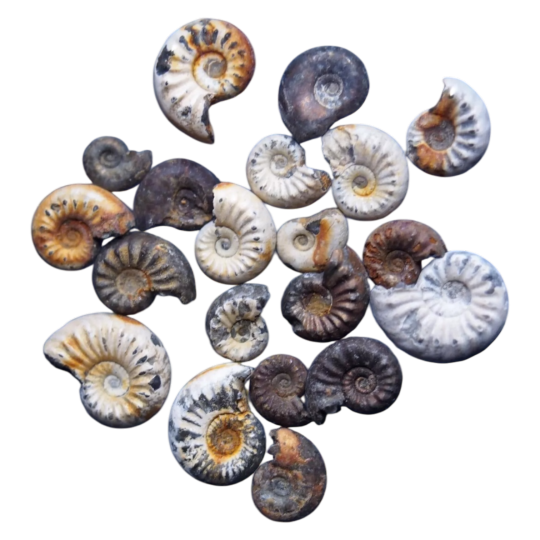
20pcs 5-8mm Pleuroceras AMMONITE Germany Fossil lot
#ammonoid#ammonite#fossil shell#fossil#fossils#multi#Germany#pleuroceras#png#transparent#aes#paleontology#prehistoric#paleoblr
679 notes
·
View notes
Text
#2775 - Paranorites sp.

Ammonites from around 252 - 247 Mya, straddling the border of the Permian and Triassic. I have no idea why this genus survived the worst mass extinction event in Earth's history when so many others didn't.
The earliest ammonoids appeared during the Early Devonian, and the last species vanishing 353 million years later during or soon after the Cretaceous–Paleogene extinction event. They were named by Pliny the Elder, who comparred the fossils to the ram's horns of the Egyptian god Amun. For the same reason, many ammonite genera end in -ceras, meaning "horn". The smallest known ammonites were Maximites, only 10mm in diameter. The largest was Parapuzosia seppenradensis, 200 times that.
Very little is known about the soft tissues of Ammonites - no soft tissue fossils were confirmed until 2021. All species were either predators or filter feeders.
In medieval Europe, fossilised ammonites were called "snakestones" or "serpentstones" and carved or painted to match the folkore.
University of Otago Geology Museum, Dunedin, Aotearoa New Zealand.
#Paranorites#Paranoritidae#University of Otago Geology Museum#Dunedin#Dunedin NZ#new zealand fossil#fossil#ammonite
0 notes
Text
The Look Into the Most Common Fossils Found in North American Sedimentary Rocks?
North America’s fossil record chronicles over 3 billion years of dramatic prehistoric life. Spanning extinct marine reptiles to Ice Age saber-tooths, North American strata have yielded some of paleontology’s most storied discoveries. In this blog, we highlight the most common fossils buried within the rocky layers of this fossil-rich continent. These extinct cephalopods dominated Mesozoic marine ecosystems for over 340 million years. Ammonoids left behind abundantly fossilized coiled shells. Read more: https://www.fossilageminerals.com/blogs/news/the-look-into-the-most-common-fossils-found-in-north-american-sedimentary-rocks

0 notes
Text
A gaggle of Ammonoids. Can you name them all?
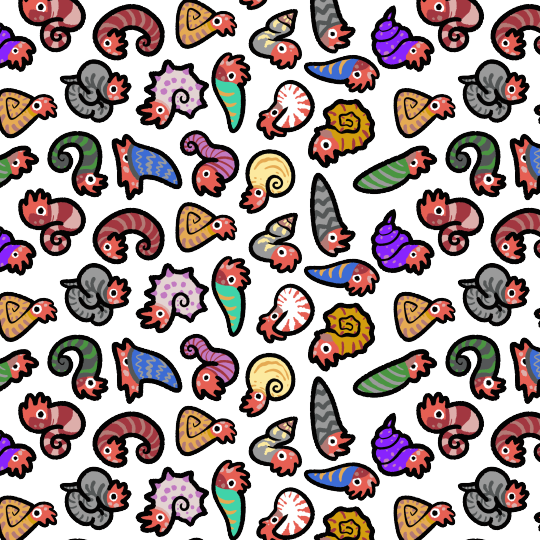
#prehistoric#paleozoic#paleoart#ammonite#ammonoids#dinosaur#fossil#fossils#digital#digitalart#pattern#patterns#cute animals#paleo art#digital art#fabric pattern designs
27K notes
·
View notes
Photo

Famennian ammonoids
33 notes
·
View notes
Photo

a fossil a day keeps the sad vibes away --- stickers! prints!
#paleoart#paleontology#procreate#mine#art#illustration#illustrators on tumblr#fossil art#paleozoic pals#stickers#didymoceras#dinovember#dinovember 2022#ammonite#ammonoid#cretaceous#palaeoblr
39 notes
·
View notes